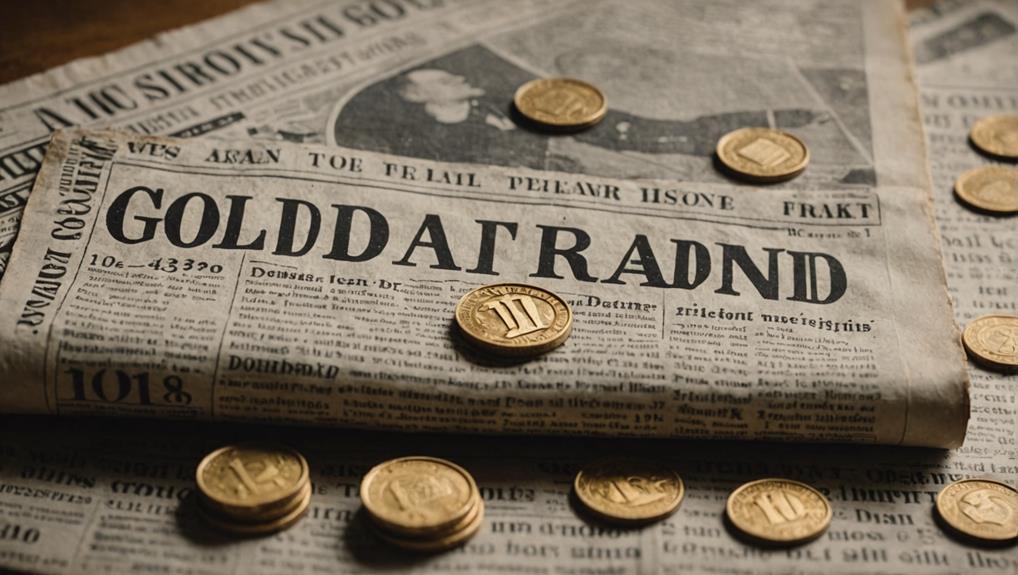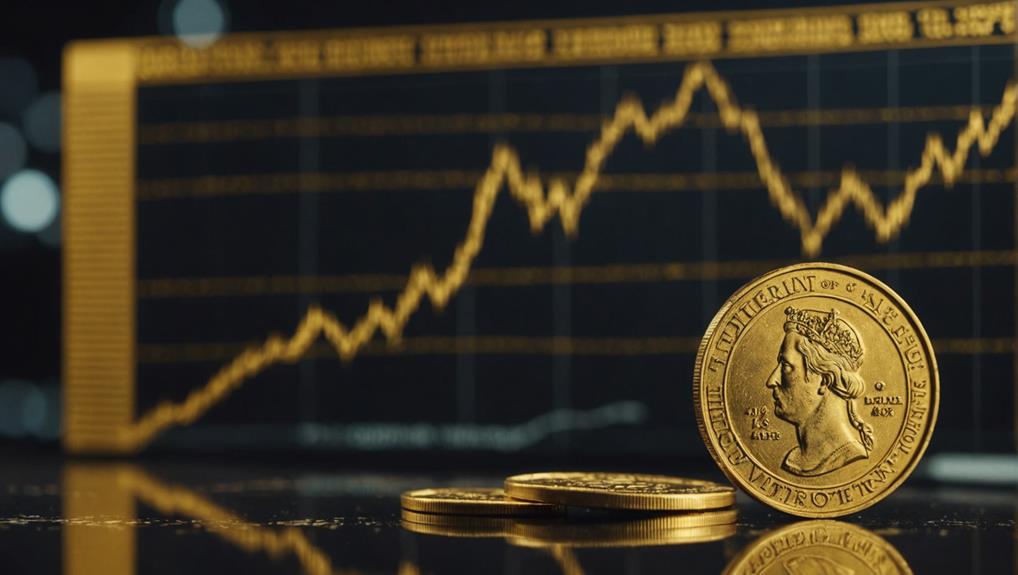The enduring legacy of gold investing is a captivating narrative that spans across ancient civilizations to modern financial systems. From its early utilization to the establishment of the gold standard, gold has served as a symbol of wealth and a reliable investment vehicle throughout history.
By exploring the significant economic events and shifts in global markets that have influenced its value, investors can gain valuable insights into navigating the complexities of today's financial landscape.
What pivotal moments have truly defined gold's timeless allure and stability?
Key Insights
- Gold's Historic Role: Gold has been a universal store of value since ancient civilizations, symbolizing wealth and power.
- Gold Standard Era: The Gold Standard anchored currencies to gold, fostering stability in international trade until its suspension in 1971.
- Investment Surge: After the gold standard ended, gold prices surged, and it became a popular investment asset and safe-haven.
- Inflation Hedge: Gold is recognized for its reliability as a hedge against inflation, appreciating in value during high inflation periods.
- Modern Investment Tools: The introduction of gold futures and ETFs has democratized gold investing, enhancing liquidity and flexibility without physical ownership.
Origins of Gold as a Valuable Commodity

Gold's role as a valuable commodity dates back to 4000 BC when it was initially prized for its beauty and scarcity in jewelry. Its appeal transcended mere adornment.
By 600 BC, the Lydians in present-day Turkey began minting gold coins, marking the inception of gold as a form of currency. Skilled goldsmiths were instrumental in this process, meticulously crafting coins and ensuring their purity and weight.
Various ancient civilizations, such as the Egyptians, Greeks, and Romans, recognized gold's intrinsic value, utilizing it as a symbol of affluence and a dependable medium of exchange.
The early adoption of gold coins and the expertise of goldsmiths laid the groundwork for gold to persist as a universal store of value throughout different cultures and time periods.
Adoption of the Gold Standard
The adoption of the Gold Standard revolutionized global monetary systems by anchoring national currencies to gold reserves and establishing fixed exchange rates. This system, known as the Classical Gold Standard, enabled direct convertibility of currencies into gold, fostering stability in international trade and investment. Despite its success, the system faced challenges leading to its decline in the early 20th century.
Following World War II, the Bretton Woods system was introduced, pegging the US dollar to gold at $35 per ounce and solidifying the dollar's position as the primary reserve currency globally. This arrangement relied heavily on US gold reserves to uphold financial stability on a worldwide scale. The subsequent transition away from the gold standard marked a shift towards fiat currencies, signaling the end of an era defined by gold-backed monetary systems.
These distinct phases in monetary history underscore the pivotal role that gold reserves played in shaping global economic frameworks.
Suspension of the Gold Standard

The suspension of the Gold Standard in 1971, initiated by President Richard Nixon, marked a crucial moment in global economic history.
This decision effectively ended the Bretton Woods system, which had pegged the US dollar to gold at a fixed rate of $35 per ounce.
The resulting shift allowed for greater flexibility in monetary policies but introduced challenges in managing international currency values and trade.
Bretton Woods System
The Bretton Woods system, established post-WWII, replaced the gold standard by pegging the US dollar to gold at $35 per ounce. This arrangement set fixed exchange rates, elevating the dollar's prominence in global trade.
Departing from the US gold standard, it reshaped central banks' gold reserves and the perception of gold as a safe haven asset.
Key elements of the Bretton Woods system included fixed exchange rates to the US dollar, capital controls for economic stability, the dollar's central role in international transactions, and the formation of institutions like the IMF and World Bank for monetary cooperation.
Nixon's 1971 Decision
President Nixon's 1971 decision to suspend the US dollar's convertibility into gold marked a pivotal shift from the gold standard to a fiat currency system. This move effectively ended the Bretton Woods system, allowing currencies to fluctuate based on market forces and government policies.
The United Kingdom, among other nations, also shifted away from the gold standard, necessitating significant economic adaptations. Critics contended that Nixon's action could potentially facilitate gold price manipulation, as markets were no longer tied to a fixed rate.
Despite this, gold maintained its status as a hedge against inflation, preserving its value in times of economic uncertainty. Nixon's choice reshaped global financial markets fundamentally, representing a critical juncture in the history of gold investment.
Economic Impact Analysis
The transition away from the gold standard in 1971 brought about a seismic shift in global economic structures. It heralded significant changes in trade balances, inflation rates, and currency valuations. This pivotal move marked the conclusion of the Bretton Woods system and ushered in a new era in global monetary policy.
The key impacts of this transition were profound:
- Exchange Rate Flexibility: Countries transitioned from fixed to floating exchange rates, enabling adjustments based on prevailing economic conditions.
- Increased Currency Volatility: The absence of the gold standard led to heightened currency fluctuations, directly impacting international trade dynamics.
- Inflation Dynamics: Governments gained more maneuverability in implementing monetary policies without the constraints of the gold standard, influencing inflation rates.
- US Dollar Dominance: With the suspension of the gold standard, the US dollar solidified its position as the primary reserve currency, effectively decoupling gold from the global monetary system.
These transformative changes fundamentally reshaped international financial practices and economic relationships.
Rise of Gold as an Investment Asset
Gold's transformation into a sought-after investment asset commenced in the 1970s following the abandonment of the gold standard and a substantial price surge. This pivotal moment marked the beginning of gold's journey as a reliable safe-haven asset, providing diversification to portfolios and serving as a shield against the erosive effects of inflation.
As the years progressed, the allure of gold continued to grow, especially amidst periods of economic uncertainty. By 2011, gold prices reached unprecedented levels, underscoring its enduring value in tumultuous financial landscapes.
Key Historical Events Influencing Gold Prices

Understanding the historical events that have influenced gold prices is crucial for grasping its role as a stable investment asset. Several key moments have significantly impacted gold market trends:
In 1933, the Gold Reserve Act was implemented following President Roosevelt's executive order, establishing gold prices at $35 per ounce and bringing stability to the gold market. This move marked a pivotal shift in the valuation of gold.
The abandonment of the gold standard by President Nixon in 1971 marked a turning point, leading to a free-floating gold price system. This decision had a profound impact on gold prices, reshaping the dynamics of the market.
During the peak of the gold market in 1980, prices surged to an inflation-adjusted high exceeding $3,300 per ounce in February. Geopolitical tensions and economic uncertainties played a significant role in driving this remarkable increase in gold prices.
The 2008 Financial Crisis underscored gold's status as a safe-haven asset, with sharp price fluctuations highlighting its resilience during times of economic turmoil. This period served as a reminder of gold's value as a reliable investment option in times of crisis.
Gold Vs. Stocks and Bonds
When comparing gold to stocks and bonds, it is crucial to consider historical performance, risk, and return.
While gold has achieved significant value appreciation since the end of the gold standard in 1971, its average annual return of 10.6% from 1971 to 2019 is typically lower than that of stocks.
Yet, gold's capacity to outperform stocks during periods of geopolitical uncertainty and inflation underscores its potential as a hedge against economic turmoil.
Historical Performance Comparison
When comparing the historical performance of gold with stocks and bonds over different time frames, distinct trends emerge. Gold exhibited a 360% increase from 1990 to 2020, while the Dow Jones Industrial Average (DJIA) saw a significant gain of 991% during the same period.
Looking closer at the 15-year span from 2005 to 2020, gold experienced a remarkable 330% growth, surpassing the DJIA's increase of 153%. Notably, in 2021 and 2022, gold outperformed stocks, driven by geopolitical uncertainties and inflation concerns.
In a broader analysis over 30 years, both gold and corporate bonds delivered similar returns of approximately 330%. This suggests that despite fluctuations in performance over shorter periods, the long-term performance of gold remains robust and competitive with traditional investment options like stocks and bonds.
Risk and Return Analysis
Analyzing the risk and return profiles of gold, stocks, and bonds provides valuable insights into their performance across different economic conditions.
Gold, supported by gold mining and production data, delivered an average annual return of 10.6% between 1971 and 2019, slightly below global stocks at 11.3%. In 2020, gold saw a remarkable return of 24.6%, showcasing strong demand dynamics. Its historical price surge from $35 to $2,000 per ounce underscores its potential for significant gains.
Corporate bonds, over the past 30 years, have yielded approximately 330% in returns, on par with gold's performance. While stocks generally outpace gold in the long term, gold may shine brighter in shorter periods, particularly amid economic uncertainties.
Gold as a Hedge Against Inflation

Gold's reputation as a reliable hedge against inflation stems from its consistent ability to retain purchasing power over time.
Historical data supports the notion that gold prices tend to increase during periods of high inflation, safeguarding investors from the devaluation of traditional assets.
This phenomenon can be attributed to various factors, such as the limited supply of gold, its longstanding role as a store of wealth, the protective shield it offers against currency devaluation, and its tendency to appreciate in value as inflation drives prices upward.
Development of Gold Futures and ETFs
The introduction of gold futures in 1974 revolutionized the gold market, providing investors with a tool to trade gold at a predetermined future price and hedge against price fluctuations.
Subsequently, the launch of gold ETFs in 2004, like the SPDR Gold Shares (GLD), offered an alternative way for investors to gain exposure to gold prices without the need to physically own the metal.
These innovations have democratized market participation, making gold investing more accessible to a broader range of investors.
Cultural Significance of Gold

The cultural significance of gold extends beyond its economic value, deeply rooted in history as an ancient symbol of wealth. It is integral in religious artifacts and a mainstay in modern jewelry.
From ancient civilizations to contemporary societies, gold's enduring allure reflects its multifaceted role as a precious metal. By examining its historical and cultural importance, we gain insight into how gold's symbolism has influenced its perception and use throughout time.
Ancient Symbol of Wealth
Gold's radiant allure and intrinsic value have universally established it as a symbol of wealth, power, and sanctity. It has played a pivotal role in various civilizations:
- Roman Empire: Gold coins epitomized economic dominance and facilitated expansive trade networks.
- Ancient Egypt: Revered as the flesh of gods, gold adorned pharaohs and held a vital role in burial rituals.
- Mesopotamia to India: Gold jewelry denoted social status and opulence, transcending cultural boundaries.
- Ceremonial Objects: Gold's sacred significance was displayed through its use in intricate artifacts.
The enduring cultural significance of gold as a symbol of luxury and opulence underscores its timeless appeal and versatility in design.
Gold in Religious Artifacts
Gold's profound significance in religious artifacts across diverse cultures underscores its representation of purity, divinity, and opulence. From the Byzantine Empire's gold coins to those of ancient India, gold has consistently been employed to elevate the spiritual and cultural significance of religious objects.
The Egyptians, Greeks, and Romans, among others, extensively incorporated gold into their temples and idols, reflecting a deep reverence for its spiritual symbolism. The use of gold sovereigns further exemplifies its importance in religious contexts, symbolizing enduring value and everlasting beauty.
This cultural reverence for gold in religious artifacts emphasizes its transcendent role in fostering a connection between humanity and the divine, enriching the sanctity of these objects through its rarity and enduring allure.
Gold in Modern Jewelry
Gold has maintained its prominent position in modern jewelry, symbolizing beauty, wealth, and cultural heritage while also embodying historical and spiritual significance. Across various cultures, gold's radiance is often linked to the sun and divine power, further enhancing its allure and symbolism in contemporary jewelry designs. Modern artisans appreciate the versatility of gold, utilizing different hues to craft one-of-a-kind pieces that blend tradition with innovation.
The cultural significance of gold is evident in various forms:
- Yellow gold: This classic choice remains timeless, celebrated for its enduring beauty.
- Goldsmith banking practices: Originating from ancient traditions, these practices have influenced modern financial systems, showcasing the enduring legacy of gold.
- Gold bars: Serving as symbols of wealth and secure investments, gold bars continue to hold significant value in today's economic landscape.
- Gold coins from the Persian Empire: These historical artifacts serve as a testament to gold's enduring value throughout the ages, reflecting its lasting importance in human history.
As gold continues to evolve in the realm of jewelry, it seamlessly blends tradition and modernity, offering a timeless appeal that transcends cultural boundaries and resonates with individuals worldwide.
Future Outlook for Gold Investing
The future outlook for gold investing remains positive, upheld by its role as a reliable hedge against inflation and economic uncertainties. With a well-established track record in turbulent times, gold stands out as a stable asset, sought after for its safe-haven qualities.
Analysts anticipate sustained demand, supported by its enduring status as a haven asset. The resilience of gold-backed currencies and the secure storage options available contribute to its enduring attractiveness. In a landscape marked by geopolitical tensions and market volatility, gold's reputation as a risk management tool is expected to grow stronger.
Investors are likely to gravitate towards gold for its stability and enduring value, cementing its position in diversified portfolios. In sum, gold investing is set to retain its significance as a cornerstone of prudent financial planning.
Conclusion
Gold's historical journey from being a symbol of wealth in ancient civilizations to becoming a modern investment asset showcases its enduring appeal and resilience. Key events like the adoption and later suspension of the gold standard, as well as the emergence of gold futures and ETFs, have significantly shaped its role in the financial landscape.
Understanding these pivotal developments offers valuable insights into gold's potential as a stable, diversified asset and its effectiveness as a hedge against inflation.
For more information on gold investing and the latest market trends, visit:
The Gold Information Network
11900 Biscayne Blvd, Ste 127B, Miami, FL 33181
(305) 449-9094
https://goldinfo.net







